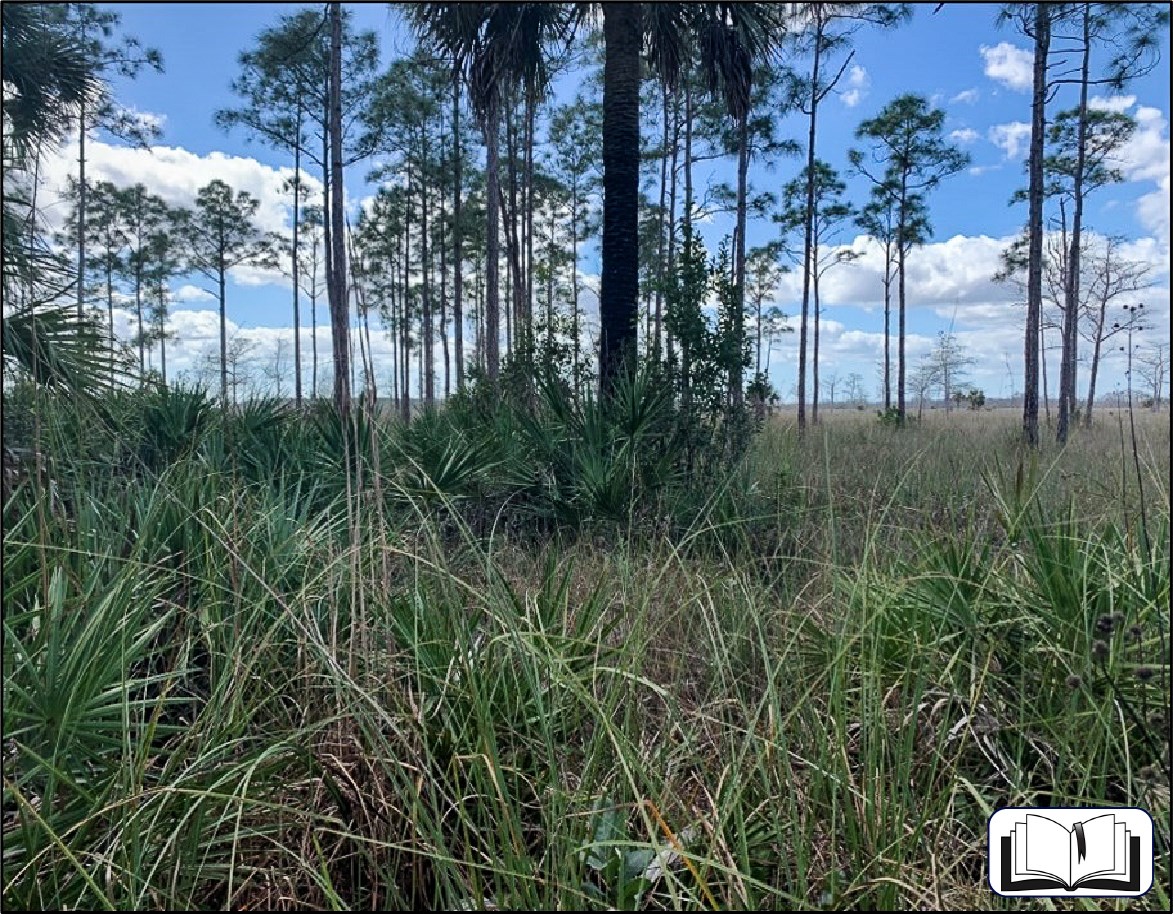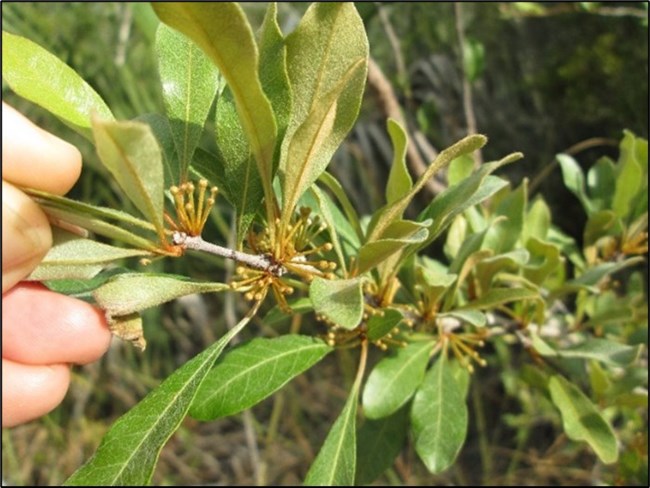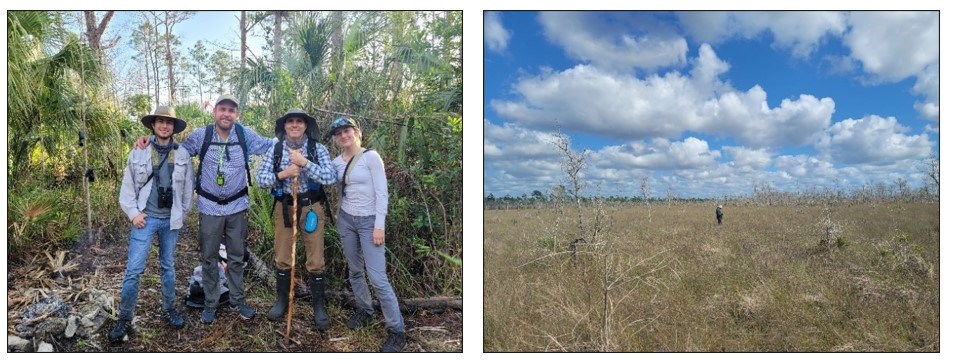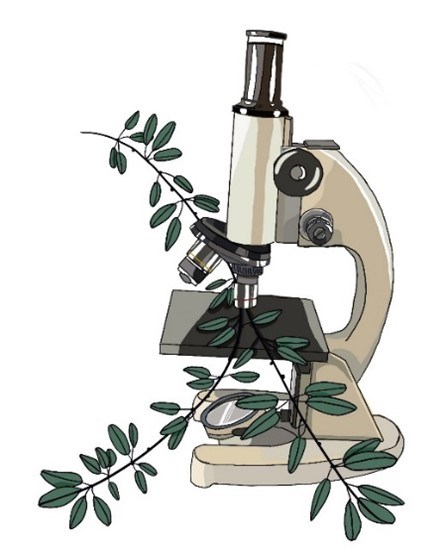Last updated: March 27, 2023
Article
Rare Plant and High-tech Microscope: A Surprising Conservation Story

NPS/Erick Revuelta
Chapter 1: The Context of Our Story
The National Park Service (NPS) preserves and recovers at-risk species, including those listed as threatened or endangered under the Endangered Species Act. Our mission includes preventing the extinction of plants and animals in national park units and restoring species that occurred in park units historically but have been lost due to a variety of reasons.

Fairchild Tropical Botanic Garden/Jennifer Possley
National park units are home to hundreds of at-risk species. These lands provide habitat for plants to grow, adapt, and expand their range, and for animals to find food, raise their young, rest, and migrate. Sometimes, national park units provide some of the last remaining habitats for a particular species. Big Cypress National Preserve (Big Cypress, or the preserve) in southwestern Florida encompasses about 729,000 acres of a freshwater swamp ecosystem. It offers refuge to a wide variety of plants and animals.
One of the many plants growing in Big Cypress is Everglades bully (Sideroxylon reclinatum subspecies austrofloridense)—a rare plant that was listed as threatened under the Endangered Species Act in 2017. Everglades bully is a native plant that’s found only in southern Florida, and was first found in the preserve in 2002. So, what does a high-tech microscope have to do with its conservation? We’ll fill you in on the story here.
Chapter 2: Siblings in Big Cypress

NPS/Erick Revuelta
Everglades bully has a very close relative. There are two subspecies, or species subdivisions, of Sideroxylon reclinatum. The first, Everglades bully (S. r. austrofloridense), is the focus, or main character, of our story. The second, Florida bully (S. r. reclinatum), plays a supporting role. Everglades bully occurs in only three counties in southern Florida (Collier, Miami-Dade, and Monroe). It typically grows in pine rockland / marl prairie ecotones (or transition areas), but can also grow in either habitat type. Big Cypress is not the only national park unit where Everglades bully grows; it can also be found in nearby Everglades National Park. Florida bully, in comparison, has a much greater range. It can be found throughout much of Florida and in coastal areas of neighboring states in the southeastern United States. However, Big Cypress National Preserve is the only place where both subspecies are known to occur together.
Outside of the preserve, where the two plants are geographically distant from one another, the two subspecies can be distinguished from one another by their appearance. Everglades bully has a fuzzy (or hairy) appearance on the undersides of its leaves and Florida bully does not. But in Big Cypress, you can’t reliably tell them apart with your naked eye (in Chapter 6, we’ll tell you why this might be).
So how do managers in the preserve monitor and protect this threatened plant if they can’t identify it? The answer—which we alluded to in the story title—is a high-tech microscope! Specifically, a scanning electron microscope. Biologists survey for the plant in the field and collect leaves, carefully recording information on where and from which plant the leaves were collected. Back in the lab, they use a microscope to examine certain characteristics of the leaves, which are different for the two subspecies on a microscopic (or micromorphological) level. The explanation of how this was discovered is another story in itself, but in short…
Several past researchers played a critical role. A first set of researchers discovered Everglades bully in the preserve in 2002. A decade later, a second set of researchers conducted surveys for the plant in Big Cypress and reported difficulties identifying Sideroxylon reclinatum to subspecies. Many of the individual plants observed had leaf characteristics (fuzziness on the undersides of the leaves) intermediate between the rare subspecies and the widespread subspecies. Then in 2014, a third set of researchers found that the two subspecies could be reliably distinguished from one another by looking at different leaf characteristics (described below) of the undersides of the leaves using a high-powered microscope.
And this brings us to recent scientific work in Big Cypress National Preserve.
Chapter 3: What did use of the Microscope tell us?
During our 2022 study in Big Cypress, we conducted on-the-ground surveys for Sideroxylon reclinatum, collected leaves from a subset of the plants documented, and used the scanning electron microscope to identify them to subspecies. This was the first time the use of this type of microscope had been combined with field surveys in the preserve. The work was conducted under the National Park Service’s Natural Resource Condition Assessment Program in partnership with Fairchild Tropical Botanic Garden. Botanists with Fairchild Tropical Botanic Garden led the field surveys and microscopy work.

Courtesy James Lange (left), NPS/James Lange (right)
Based on the study, we also found an expansion in the known range of Everglades bully. Plants were located more than 10 miles from previously known locations. We also found that several populations of the plants were mixed. In other words, the populations contained both the threatened and widespread subspecies, with plants sometimes only several feet apart.
Chapter 4: Looking Through the Microscope
As mentioned previously, past researchers found that they could tell the two subspecies apart in the lab using a scanning electron microscope. Specifically, they found that the epidermis (or outermost “skin” layer) of the undersides of the leaf blades had a different appearance in the two plants. The images below, from our current study, show this difference. Take a look!
Compare the differences at a microscopic scale: Click and drag the round slider in the middle of the photos to compare.


Left image
Scanning electron microscope image of S. r. austrofloridense (Everglades bully). The cells of the leaf surface (epidermis) have visible grooves (think of a turtle shell). The darker, “mouth-like” openings are stomata, which enable plants to “breathe.”
Credit: Photo taken at Florida Center for Analytical Microscopy, Florida International University, by J. Lange (for NPS) and T. Beasley (FIU).
Right image
SEM image of S. r. reclinatum (Florida bully). Compared to the image on the left, there are no grooves—only elevated ridges on an otherwise smooth-looking surface (think of crinkled aluminum foil). The darker, “mouth-like” openings are stomata.
Credit: Photo taken at Florida Center for Analytical Microscopy, Florida International University, by J. Lange (for NPS) and T. Beasley (FIU).
Chapter 5: Using the Study to Help Protect Everglades Bully
The findings of this study provide more information on Everglades bully than existed previously, and this will help in conservation of the subspecies throughout its small range. In Big Cypress National Preserve, knowledge of the plant’s newly expanded range is being incorporated into project planning throughout the preserve. Also, findings of the study on Everglades bully’s occurrence and range may support designating critical habitat for the subspecies by the U.S. Fish and Wildlife Service, which would further protect the plant and influence its management.
Chapter 6: What Questions Remain?
Why do these two plants look so much alike where their ranges overlap? Are we observing evolution in progress? And if so, is it headed in a particular direction?
Our 2022 study in Big Cypress found that some populations of these plants were mixed, sometimes with individuals of the two subspecies just several feet from one another. Although to the naked eye all plants examined looked most like the widespread subspecies, using the microscope the vast majority of the plants were identified as the threatened subspecies. Without the fuzzy leaf undersides that are characteristic of Everglades bully, this population appears intermediate between the two forms. Perhaps the plants in this area have evolved the microscopic characters prior to developing the fuzziness, but it is also possible that the intermediate form is due to genetic mixing. The plants in Big Cypress are at the edge of their respective ranges, and in this area of overlap they may be actively hybridizing. The mixing of hybrid and parental DNA often leads to unique traits and is considered an important driver of evolutionary change. Genetic studies would help us understand if one subspecies is “winning” this evolutionary competition of spreading their genes, or if plants in Big Cypress are on a path toward being something altogether unique.
The End… …until researchers learn more!

.
Glossary
Everglades bully was listed as threatened by the U.S. Fish and Wildlife Service due to several reasons, including habitat loss and modification from urban and agricultural development, lack of adequate fire management, non-native invasive plants, events such as hurricanes and wildfire, and sea level rise. In Big Cypress, pressures include off-road vehicle disturbance, competition with non-native invasive plants, and alterations in natural fire and hydrology patterns.
A subspecies is a rank below species; it refers to a smaller group within a species. Individuals that are a different subspecies may arise due to geographic separation or variation in environmental factors associated with habitat. Therefore, they typically vary in size, shape, color, or other physical aspect, but they are able to cross breed (or hybridize) and produce viable offspring.
References
Bradley, K.A., S.W. Woodmansee, J.L. Sadle, and G.D. Gann. 2005. A quantitative plant inventory of the Big Cypress National Preserve. Report submitted to the National Park Service Inventory and Monitoring Program, Miami, Florida by The Institute for Regional Conservation.
Bradley, K.A., G.D. Gann, C. van der Heiden, and S. Green. 2013. Status survey of Everglades bully and Florida pineland crabgrass in the Big Cypress National Preserve, Florida. Report submitted to U.S. Fish and Wildlife Service, Vero Beach, Florida by the Institute for Regional Conservation with Mitigation Resources.
Corogin, P.T., and W.S. Judd. 2014. New geographical and morphological data for Sideroxylon reclinatum subspecies austrofloridense (Sapotaceae), a taxon endemic to southeastern peninsular Florida, USA. Journal of the Botanical Research Institute of Texas 8(2):403–417.

Information in this article is based on a Focused Condition Assessment and publication "Population Assessments of Federally Threatened Everglades Bully in Big Cypress National Preserve, Florida, USA, Using Habitat Suitability Modeling and Micromorphology" by J. Lange, C.L. Angelo, E. Revuelta and J. Possley.
